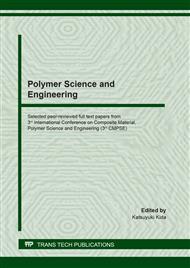p.3
p.14
p.20
p.27
p.33
p.41
p.47
p.53
Ultrasonic Welding of Glass Fiber Reinforced PP Thermoplastic Composites: An Investigation of the Outer Layer Orientation and the Fiber Volume Fraction
Abstract:
This paper presents an experimental study of the influence of the orientation of the outer layer of polypropeylene (PP) reinforced with E-glass fiber laminate (GF/PP) and the influence of the fiber volume fraction on the quality of the welded joint using an ultrasonic welding process. An orthogonal L 16 array (OA) design of experiment was conducted in this paper based on the Taguchi method to evaluate the effect of the orientation of the outer layer and the fiber volume fraction, on the welding process parameters; the welding energy, the amplitude of vibration, the welding pressure, the holding pressure and the holding time were considered in order to achieve a high weld quality. The experiments were carried out using a 15 kHz ultrasonic welding unit with a maximum supplied power of 4000-Watt. GF/PP laminates with fiber volume fraction of 36% and 46% were used in this paper, and the GF/PP laminates were either unidierctional or had a 90 degree outer layer orienation. A 0.127 mm thick polypropeylene film was used as a flat energy director (ED). The evaluation of the weld quality was measured by the apparent shear strength of the single lap welded joints, and by using laser shearography as a non-destructive inspection technique . The failure mechanism of the single lap joint was monitored, using a high speed digital imaging system. A combination of the highest selected level of welding energy, lowest level of amplitude, lowest level of welding pressure, and the lowest level of both hold time and hold pressure of a unidirectional GF/PP with the lowest fiber volume fraction, were found to achieve a higher apparent shear strength of the welded adherends, as compared with the apparent shear strength obtained with the presence of the flat energy director for the same level of factors. A confirmation experiment was conducted to measure the predicted apparent shear strength and compare it with the measured apparent shear strength from the test.
Info:
Periodical:
Pages:
3-13
Citation:
Online since:
August 2020
Authors:
Price:
Сopyright:
© 2020 Trans Tech Publications Ltd. All Rights Reserved
Share:
Citation:


